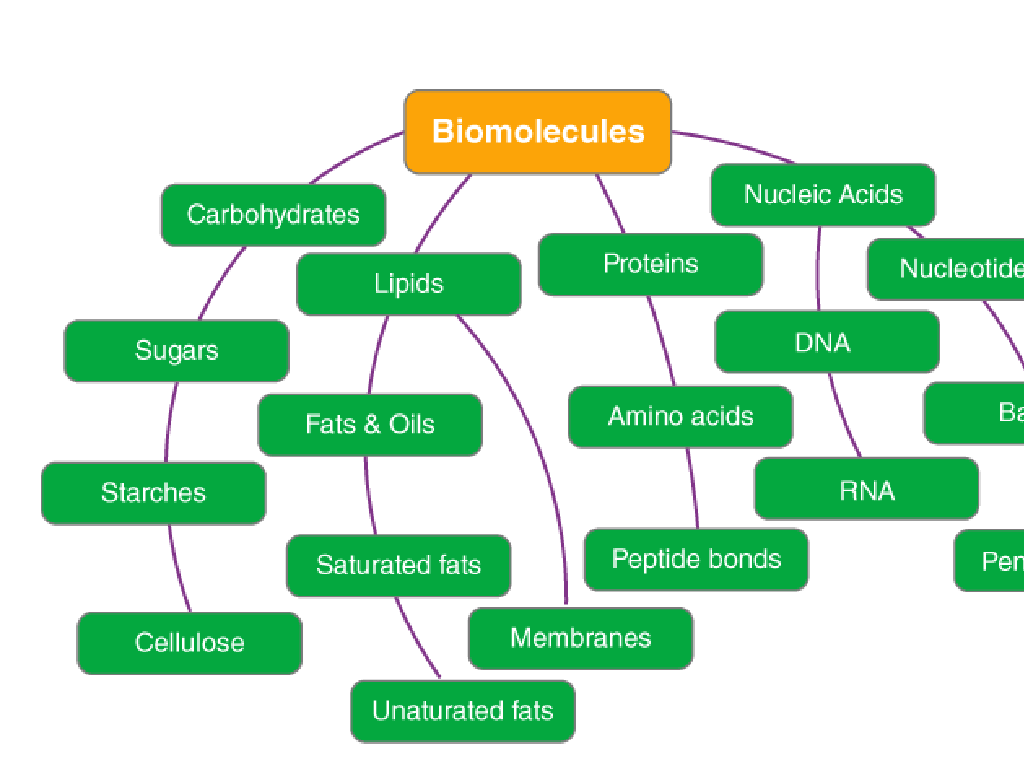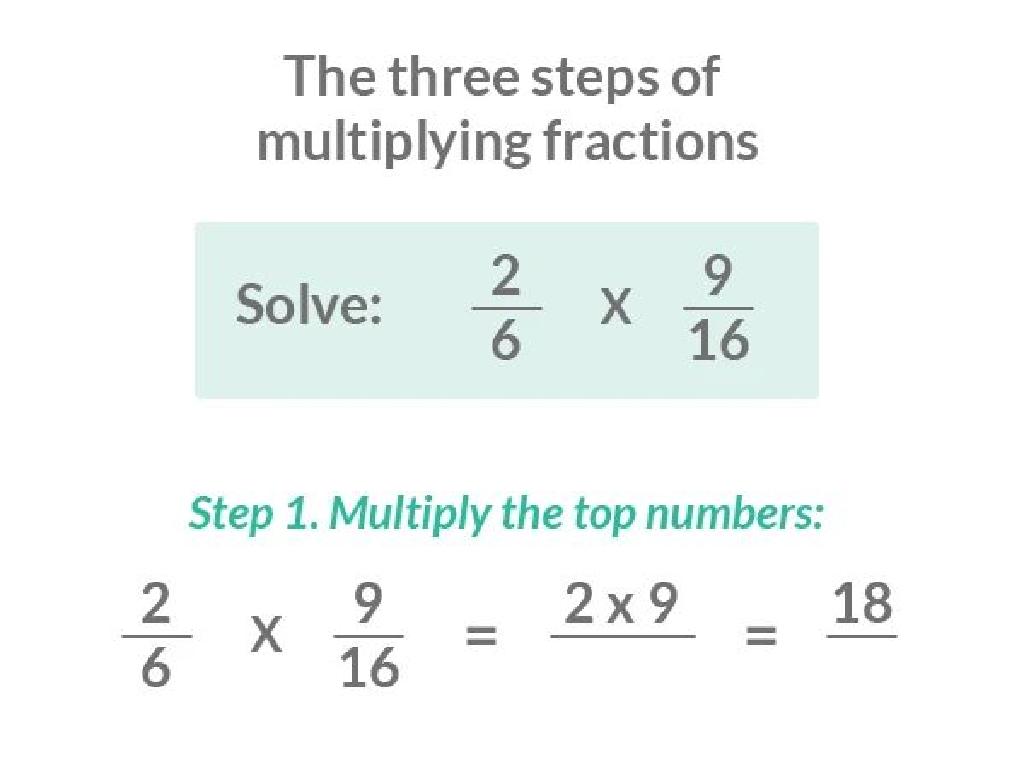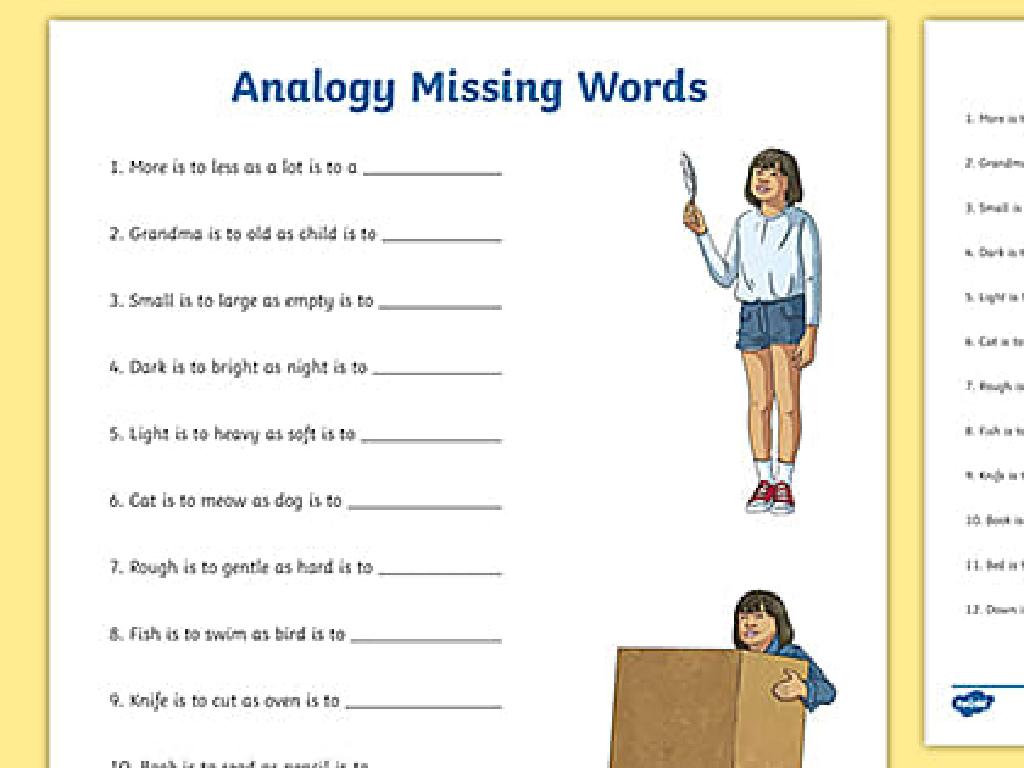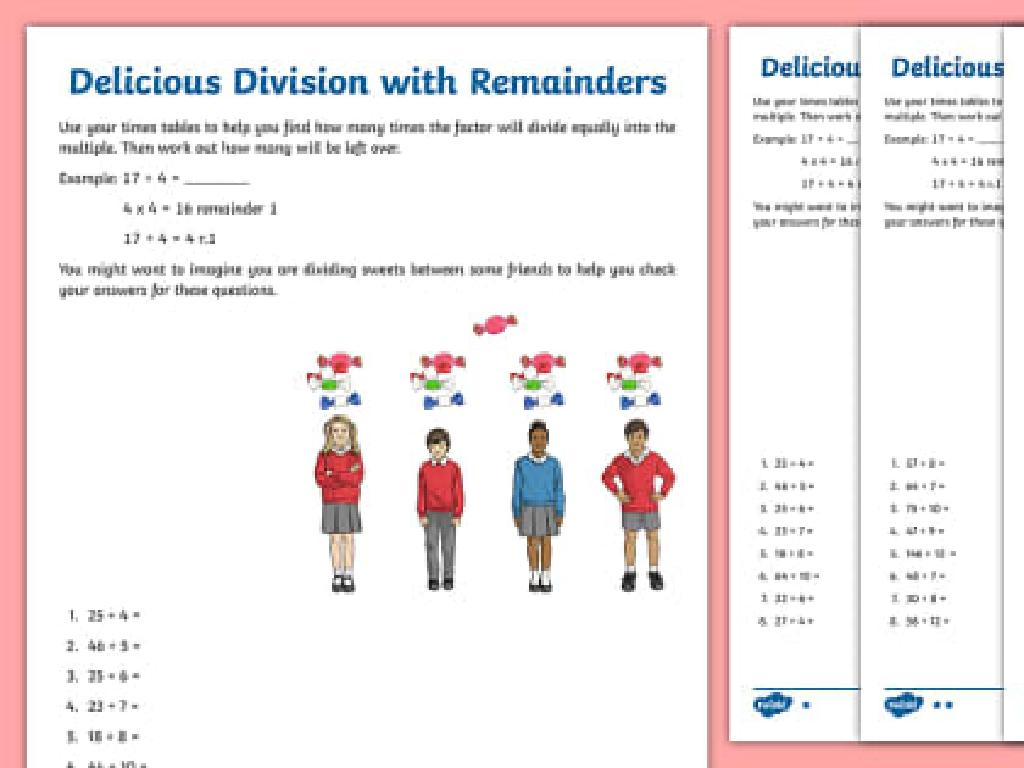Identify All Of The Possible Antecedents
Subject: Language arts
Grade: Eighth grade
Topic: Pronouns And Antecedents
Please LOG IN to download the presentation. Access is available to registered users only.
View More Content
Pronouns and Antecedents: Making the Connection
– Define pronouns and antecedents
– Pronouns replace nouns; antecedents are the nouns being replaced.
– Explore the pronoun-antecedent relationship
– Pronouns must agree with their antecedents in number, gender, and person.
– Importance of correct matching
– Ensures clarity and avoids confusion in sentences.
– Consequences of mismatching
– Mismatches can lead to vague or incorrect sentences, affecting comprehension.
|
This slide introduces the concept of pronouns and antecedents, emphasizing the importance of their correct usage in sentence construction. Start by defining pronouns as words that take the place of nouns, and antecedents as the nouns to which pronouns refer. Explain that for clear and coherent sentences, pronouns must match their antecedents in number (singular or plural), gender (masculine, feminine, or neutral), and person (first, second, or third). Highlight the significance of this match to avoid ambiguity and ensure the reader understands exactly what or whom the pronoun is referring to. Discuss the potential confusion that can arise from incorrect pronoun-antecedent agreement with examples. Encourage students to practice identifying pronouns and their antecedents in sentences and to correct mismatches they may encounter.
Understanding Pronouns and Antecedents
– Define a pronoun
– A word used instead of a noun
– Examples: he, she, it, they
– ‘He’ for a boy, ‘she’ for a girl, ‘it’ for an object, ‘they’ for a group
– Pronouns replace nouns
– Avoids repetition, making sentences smoother
– Antecedents: words pronouns refer to
– Must agree in number and gender with the pronouns they replace
|
This slide introduces the concept of pronouns and their antecedents, which is crucial for understanding sentence structure and coherence. Pronouns are words that take the place of nouns to avoid repetition and make sentences flow better. Examples include ‘he,’ ‘she,’ ‘it,’ and ‘they.’ Antecedents are the nouns or phrases that a pronoun refers to in a sentence. It’s important that pronouns agree with their antecedents in both number (singular or plural) and gender. Instruct students to identify pronouns in sentences and determine their antecedents for practice. This will help them in writing clear and concise sentences.
Understanding Antecedents in Grammar
– Define an antecedent
– An antecedent is a word that a pronoun refers to in a sentence.
– Relation to pronouns
– Pronouns replace antecedents to avoid repetition and aid coherence.
– Examples in sentences
– ‘Lisa found her jacket.’ – ‘her’ refers to ‘Lisa’.
– Practice identifying antecedents
|
This slide introduces the concept of antecedents and their relationship with pronouns. An antecedent is the noun or noun phrase that a pronoun refers to earlier in the text. Understanding this relationship is crucial for ensuring clarity in writing and speech. Provide clear examples where pronouns replace specific nouns, and highlight how this helps avoid repetition and maintain smooth reading. Encourage students to practice by identifying antecedents in sample sentences and in their own writing. This foundational knowledge will aid in their understanding of more complex grammatical structures.
Matching Pronouns and Antecedents
– Pronoun-antecedent agreement rule
– A pronoun must match its antecedent in number, gender, and person.
– Singular vs. plural antecedents
– Singular antecedents take ‘he/she/it’, plural take ‘they’.
– Gender-specific pronoun use
– Use ‘he’ or ‘she’ for known gender, ‘they’ for unknown or non-binary.
– Neutral pronouns and inclusivity
– ‘They’ can also be singular for gender neutrality.
|
This slide introduces the concept of pronoun-antecedent agreement, which is crucial for clarity in writing. Emphasize that pronouns must agree with their antecedents in number (singular or plural), gender (male, female, non-binary), and person (first, second, third). Provide examples of singular and plural antecedents and how pronouns should match accordingly. Discuss the use of gender-specific pronouns and the growing acceptance of ‘they’ as a singular, gender-neutral pronoun. Encourage students to be mindful of inclusivity when choosing pronouns. Prepare exercises where students identify antecedents and select the correct pronouns, ensuring they understand the agreement rules.
Identifying Antecedents in Sentences
– Strategies to find pronoun antecedents
– Use context, prior sentences, and logic to link pronouns to nouns.
– Clues within sentence structure
– Sentence parts like subject, verb, and object can guide you to antecedents.
– Practice with sample sentences
– Let’s analyze examples together to identify antecedents effectively.
|
This slide aims to equip students with the skills to identify antecedents of pronouns in sentences. Emphasize the importance of understanding context and looking at the surrounding sentence structure to find the noun that the pronoun is referring to. Provide strategies such as considering the gender and number agreement between the pronoun and its antecedent, and using logic based on the information given in prior sentences. During practice, use sample sentences to illustrate these strategies in action, allowing students to apply what they’ve learned. Encourage students to ask questions if they’re unsure about how to find an antecedent. The goal is for students to become proficient in linking pronouns to their correct antecedents, enhancing their reading comprehension and writing clarity.
Tricky Antecedents in Pronouns
– Handling multiple nouns
– When sentences have more than one noun, decide which noun the pronoun refers to.
– Using context for clarity
– Context is key to figuring out which noun matches the pronoun.
– Resolving sentence ambiguities
– Look at tricky sentences and learn strategies to find clear antecedents.
– Practice with examples
|
This slide addresses the complexity of identifying antecedents when pronouns are used in sentences with multiple nouns. Emphasize the importance of context in determining the correct antecedent for a given pronoun. Provide examples of sentences with ambiguous pronoun references and guide students through the process of resolving these ambiguities. Encourage students to practice by identifying pronouns and their possible antecedents in various sentences, discussing as a class why one antecedent may be more likely than another based on context. This will help them develop a deeper understanding of how pronouns and antecedents work together to create clear and coherent sentences.
Class Activity: Find the Antecedents
– Identify worksheet antecedents
– Pair up for discussion
– Work with a partner to explore different possibilities
– Determine antecedents together
– Use context clues to link pronouns to their antecedents
– Class review of answers
|
This activity is designed to help students practice identifying antecedents of pronouns within sentences. Provide a worksheet with sentences containing pronouns and ask students to work in pairs to discuss and determine the possible antecedents. Encourage them to consider the context and to look for clues that indicate which word the pronoun is referring to. After the activity, bring the class together to review the answers, allowing students to explain their reasoning and understand any mistakes. This collaborative approach not only reinforces the concept of antecedents but also develops critical thinking and discussion skills.
Conclusion: Mastering Antecedents in Pronouns
– Recap: Importance of antecedents
– Correct antecedents ensure clarity in writing and speaking.
– Review strategies for finding antecedents
– Look for noun antecedents before the pronoun and check for agreement.
– Encourage questions and clarifications
– A safe space to ask questions leads to better understanding.
– Practice makes perfect
|
As we wrap up today’s lesson on pronouns and their antecedents, it’s crucial to emphasize the importance of correctly identifying antecedents to avoid ambiguity in communication. Review the strategies discussed earlier, such as looking for the noun that the pronoun refers to and ensuring that the pronoun agrees in number and gender with its antecedent. Encourage students to actively participate by asking questions or expressing any doubts they may have. This will help solidify their understanding and provide an opportunity for clarification. Lastly, remind students that practice is key to mastering this concept. Assign practice exercises for homework and offer additional resources for further learning.






